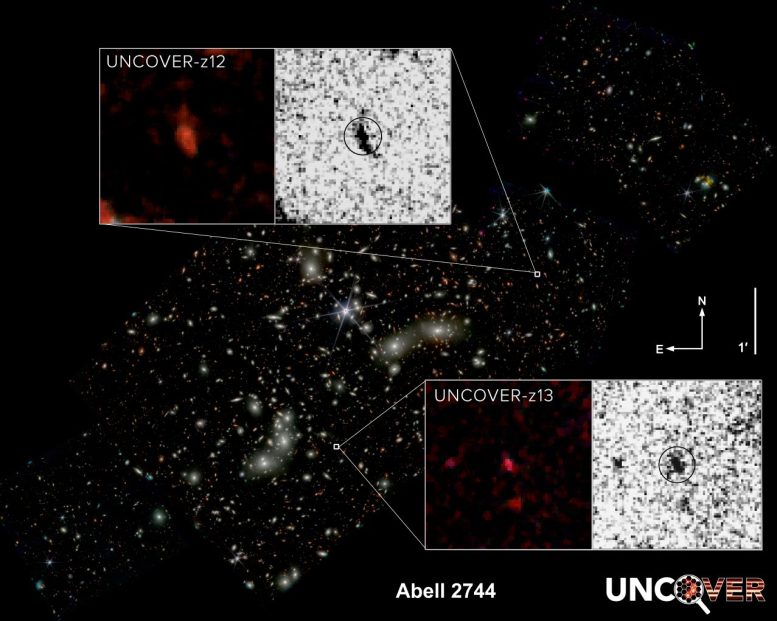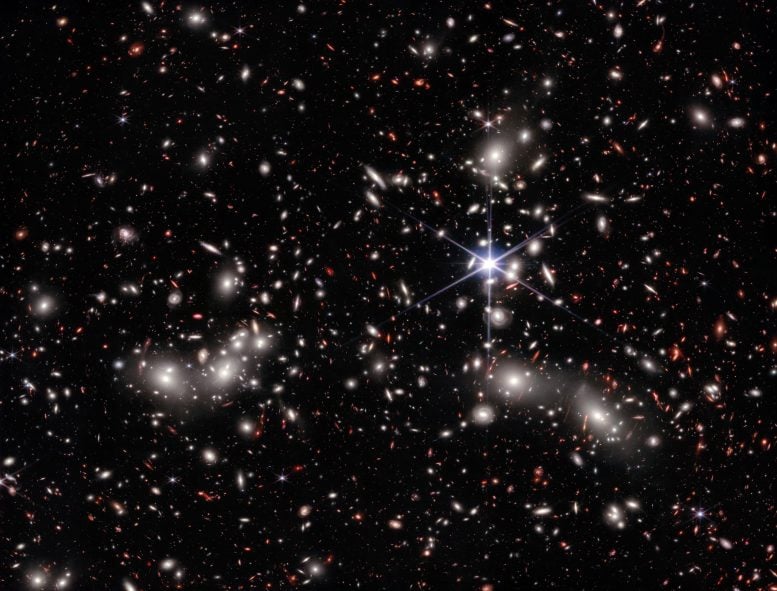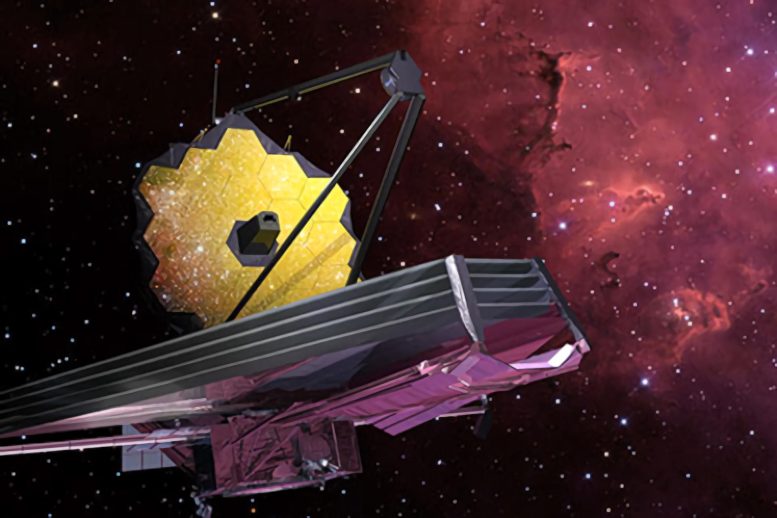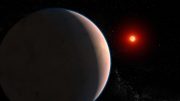
The second- and fourth-most distant galaxies ever seen (UNCOVER z-13 and UNCOVER z-12) have been confirmed using the James Webb Space Telescope’s Near-Infrared Camera (NIRCam). The galaxies are located in Pandora’s Cluster (Abell 2744), show here as near-infrared wavelengths of light that have been translated to visible-light colors. The scale of the main cluster image is labelled in arcseconds, which is a measure of angular distance in the sky. The circles on the black-and-white images, showing the galaxies in the NIRCam-F277W filter band onboard JWST, indicate an aperture size of 0.32 arcsec. Credit: Cluster image: NASA, UNCOVER (Bezanson et al., DIO: 10.48550/arXiv.2212.04026) Insets: NASA, UNCOVER (Wang et al., 2023) Composition: Dani Zemba/Penn State
Follow-up observations in Pandora’s cluster confirmed the second- and fourth-most distant galaxies ever seen, which are larger than other galaxies at such extreme distances.
The second- and fourth-most distant galaxies ever observed have been discovered in a region of space known as Pandora’s Cluster, or Abell 2744, using data from NASA’s James Webb Space Telescope (JWST). Following up on a deep field image of the area (see image below), an international team led by Penn State researchers confirmed the distance of these ancient galaxies and inferred their properties using new spectroscopic data — information about light emitted across the electromagnetic spectrum — from JWST. At nearly 33 billion light years away, these incredibly distant galaxies offer insights into how the earliest galaxies might have formed.
Unique Appearance and Significance
Unlike other galaxies confirmed at this distance that appear in images as red dots, the new galaxies are larger and appear like a peanut and a fluffy ball, according to the researchers. A paper describing the galaxies appears today (November 13) in the journal Astrophysical Journal Letters.

Astronomers estimate 50,000 sources of near-infrared light are represented in this deep field image of Pandora’s Cluster from NASA’s James Webb Space Telescope. Their light has traveled through varying distances to reach the telescope’s detectors, representing the vastness of space in a single image. Credit: Science: NASA, ESA, CSA, Ivo Labbe (Swinburne), Rachel Bezanson (University of Pittsburgh), Image Processing: Alyssa Pagan (STScI)
“Very little is known about the early universe, and the only way to learn about that time and to test our theories of early galaxy formation and growth is with these very distant galaxies,” said first-author Bingjie Wang, postdoctoral scholar in the Penn State Eberly College of Science and a member of the JWST UNCOVER (Ultradeep NIRSpec and NIRCam ObserVations before the Epoch of Reionization) team that conducted the research. “Prior to our analysis, we knew of only three galaxies confirmed at around this extreme distance. Studying these new galaxies and their properties has revealed the diversity of galaxies in the early universe and how much there is to be learned from them.”
Insights Into Early Universe
Because the light from these galaxies had to travel for so long to reach Earth, it provides a window into the past. The research team estimates that the light detected by JWST was emitted by the two galaxies when the universe was about 330 million years old and traveled for about 13.4 billion light years to reach the JWST. But, the researchers said, the galaxies are currently closer to 33 billion light years away from Earth due to the expansion of the universe over this time.
“The light from these galaxies is ancient, about three times older than the Earth,” said Joel Leja, assistant professor of astronomy and astrophysics at Penn State and a member of UNCOVER. “These early galaxies are like beacons, with light bursting through the very thin hydrogen gas that made up the early universe. It is only by their light that we can begin to understand the exotic physics that governed the galaxy near the cosmic dawn.”

Using the James Webb Space Telescope, scientists have found two distant galaxies in Pandora’s Cluster, providing new insights into the early universe. These galaxies, unique in size and appearance, challenge our understanding of galaxy formation in the cosmos’ infancy. Credit: NASA
Notably, the two galaxies are considerably larger than the three galaxies previously located at these extreme distances. One is at least six times larger at about 2,000 light-years across. For comparison, the Milky Way is approximately 100,000 light-years across, but, Wang said, the early universe is thought to have been very compressed, so it’s surprising that the galaxy is as large as it is.
“Previously discovered galaxies at these distances are point sources — they appear as a dot in our images,” Wang said. “But one of ours appears elongated, almost like a peanut, and the other looks like a fluffy ball. It is unclear if the difference in size is due to how the stars formed or what happened to them after they formed, but the diversity in the galaxy properties is really interesting. These early galaxies are expected to have formed out of similar materials, but already they are showing signs of being very different than one another.”
Research Methodology
The two galaxies were among 60,000 sources of light in Pandora’s Cluster detected in one of JWST’s first deep field images taken during 2022, its first year of science operations. This region of space was selected in part because it is located behind several galaxy clusters that create a natural magnification effect called gravitational lensing. The gravitational pull of the clusters’ combined mass warps the space around it, focusing and magnifying any light that passes nearby and providing a magnified view behind the clusters.
In a matter of months, the UNCOVER team narrowed down the 60,000 light sources to 700 candidates for follow up study, eight of which they thought could potentially be among the first galaxies. Then, JWST again pointed at Pandora’s Cluster, recording the candidates’ spectra — a sort of fingerprint detailing the amount of light given off at each wavelength.
“Several different teams are using different approaches to look for these ancient galaxies, and each have their strengths and weaknesses,” Leja said. “The fact that we’re pointing at this giant magnifying lens in space gives us an incredibly deep window, but it’s a very small window so we were rolling the dice. Several of the candidates were inconclusive, and at least one was a case of mistaken identity — it was something much closer that mimics a distant galaxy. But we were lucky, and two turned out to be these ancient galaxies. It’s incredible.”
Properties and Implications
The researchers also used detailed models to infer the properties of these early galaxies when they emitted the light detected by JWST. As the researchers expected, the two galaxies were young, had few metals in their composition, and were growing rapidly and actively forming stars.
“The first elements were forged in the cores of early stars through the process of fusion,” Leja said. “It makes sense that these early galaxies don’t have heavy elements like metals because they were some of the first factories to build those heavy elements. And, of course, they would have to be young and star-forming to be the first galaxies, but confirming these properties is an important basic test of our models and helps confirm the whole paradigm of the Big Bang theory.”
The researchers noted that, alongside the gravitational lens, JWST’s powerful infrared instruments should be able to detect galaxies at an even further distance, if they exist.
“We had a very tiny window into this region, and we didn’t observe anything beyond these two galaxies, even though JWST has the capability,” Leja said. “That could mean that galaxies just didn’t form before that time and that we’re not going to find anything further away. Or it could mean we didn’t get lucky enough with our small window.”
This work was the result of a successful proposal submitted to NASA suggesting how to use JWST during its first year of science operations. In the first three cycles of submissions, NASA received four to ten times more proposals than available observing time on the telescope would allow and had to select only a fraction of those proposals.
“Our team was very excited and a little surprised when our proposal was accepted,” Leja said. “It involved coordination, quick human action, and the telescope pointing at the same thing twice, which is a lot to ask of a telescope in its first year. There was a lot of pressure because we only had a few months to determine the objects for follow up. But JWST was built for finding these first galaxies, and it’s so exciting to be doing that now.”
Reference: “UNCOVER: Illuminating the Early Universe—JWST/NIRSpec Confirmation of z > 12 Galaxies” by Bingjie Wang, 冰洁 王, Seiji Fujimoto, Ivo Labbé, Lukas J. Furtak, Tim B. Miller, David J. Setton, Adi Zitrin, Hakim Atek, Rachel Bezanson, Gabriel Brammer, Joel Leja, Pascal A. Oesch, Sedona H. Price, Iryna Chemerynska, Sam E. Cutler, Pratika Dayal, Pieter van Dokkum, Andy D. Goulding, Jenny E. Greene, Y. Fudamoto, Gourav Khullar, Vasily Kokorev, Danilo Marchesini, Richard Pan, John R. Weaver, Katherine E. Whitaker and Christina C. Williams, 13 November 2023, The Astrophysical Journal Letters.
DOI: 10.3847/2041-8213/acfe07
In addition to Penn State, the team includes researchers from the University of Texas Austin, the Swinburne University of Technology in Australia, Ben-Gurion University of the Negev in Israel, Yale University, the University of Pittsburgh, Sorbonne Université in France, the University of Copenhagen in Denmark, the University of Geneva in Switzerland, the University of Massachusetts, the University of Groningen in the Netherlands, Princeton University, Waseda University in Japan, Tufts University and the National Optical-Infrared Astronomy Research (NOIR) Lab.
This work was supported by NASA, the United States-Israel Binational Science Foundation, the U.S. National Science Foundation, the Israel Ministry of Science & Technology, the French National Centre for Space Studies, the French National Institute for Earth Sciences and Astronomy, the Research Corporation for Scientific Advancement, the Dutch Research Council, the European Commission’s and University of Groningen’s CO-FUND Rosalind Franklin program, the National Astronomical Observatory of Japan and the NOIR Lab.









This astronomy knowledge is still not mature and never will. You’ll discover many things in the future, things that does not known to billion of humans buried underneath the ground that never benefited from your findings. What is the purpose of this creation? Believe in God and continue the research.
Thanks for the godidiot point of view. It’s funny to see how morons squirm when their belief systems are challenged.
Please elaborate
Guys really just “double time” …
Time 20 location 9 of course I” M is 13 the original 13 colony’s 13 folds to our great flag .. so time 209135 x 2 =
4(1827)0 war does sick things to the mind I don’t mind telling you I was born 27 Dec my child 18 Dec .. 9X3=27 6X3 = 18.. if 69 if 69 if 69 .. if you doubt God I feel very sorry for you … Please reconsider Gods reach in this world at this time I have to tell you the way I see life respectively God made it the way it is so simple people like myself could get a grip after combat war never is fought by man alone wake up please understand this is my real fight with reality everyday faith heals me . You guys are justified totally for your views all have valid points. Add your names then multiply them by the word you may see even.
Are you okay kerry?
“33 billion light Years Away” Is this a typo? The universe is currently known to be 13 billion years old. Therefore no objects could be farther away in time. The article implies that these galaxies were formed 20 billion years before the formation of the universe.
RTFA.
“…light detected by JWST was emitted by the two galaxies when the universe was about 330 million years old and traveled for about 13.4 billion light years to reach the JWST. But, the researchers said, the galaxies are currently closer to 33 billion light years away from Earth due to the expansion of the universe over this time.”
I really don’t know why, despite the observation of these galaxies, which are at least 13.4 billion years old, and the age of the universe, which is 13.8 billion years according to the standard model of the Big Bang, but despite this, the standard model of the Big Bang theory is not abandoned? What other reasons should there be? These reasons are: 1- The lack of justification for the existence of these galaxies at the beginning of the expansion of the universe. 2- Finding chains of carbon materials in this type of early galaxies. 3- Failure to justify the predicted singularity in the early moments of the Big Bang and after. 4- The lack of justification for excessive symmetry that was applied and dominated the world in the early moments of the Bang. 5- Lack of justification for the existence of dark matter. 6- But most importantly, the lack of prediction and justification and proper interpretation for the prediction and justification of dark energy based on the standard Big Bang theory. Someone please explain to me whether the presence of gravitational waves or cosmic background microwaves alone is the reason for the 100% correctness of the Big Bang theory?
Currently, only a big bang model explains most of the observations. All other models fail at far more. So yeah, it’s not perfect, but it’s the best we’ve got at the moment – until something better comes along.
God has no place in this discussion. Period! Maybe fairytales with imaginary friends..?
Only a complete fool discounts anything until it is disproven. Who sparked the Big Bang then, smarty pants?
We do not know. Therefore we should not judge. it does not make sense to judge “oh it was the god!” When we do not know who or what did it. We should keep study and research about it rather than judge that it was a work of the god then ignore the studying and researching.
It is similar to say that “i do not know who stole my iphone but that guy looks angry and dangerous thus it must be that guy.”
So something is wrong.
1. The universe is much older than we thought.
2. Red Shift theory is wrong.
3. Could we have two universes existing together one is much older?
Well, we do not really know anything and these guys make it sound like they were all there and experienced it. We are here and exist either because of billions of years and chance particle encounters, or we were created by an amazing God who came to Earth as Jesus. Science is pointing to a creator more and more. Plus scripture makes a compelling case for God.
Ricky… if we do not know then we should stop to find out, such as studying it and researching on it.
“We do not know therefore god did it” is a quite a judgemental yet narrow view innit?
I lost my iphone the other day. However, i do not like your name rick D. So i think it was you that stole my iphone.
The above logic similar to the “it was the god” logic
Hello, I think that why the speed of the expansion of galaxies is more than the speed of light, even if it is equal to the speed of light, from the place of the Big Bang, from the opposite direction, the maximum distance should be about twenty eight billion years, not more.
Well, based on the general relativity we do not have any object such as galaxies that they can exceed of the speed of light but because our universe is expanding from the time of the Big Bang then expansion of the universe (not expansion of galaxies) can be ocuured more than the speed of light since this expansion is out of our universe and its laws. If you consider that the speed of expansion of our universe is increasing during the time then you can calculate that the maximum distance between the galaxies could be between 39 to 46 billion light-years.
I may observation universe is not expanding like whate they said, it’s already thier endless,dark.when u light it up looks like expanding but not. And “Big Bang” are not true just an imagination of mind.
How do you see something 33 billion light years away if the universe is less than that.
I don’t understand why science doesn’t accept the universe is infinite and eternal .
God created the universe and who created GOD ?
When one introduces G-d into anything, it harkens back to the period when radio waves traveled through the “Ether” as it was the only method used to describe it. The JWST is the true messenger of truth beyond our understanding of what our universe is and is not. I wait patiently for humans to be surprised to find more devices to go beyond the capability of JWST, unless there is a thermo-nuclear war that annihilates all prior knowledge and setting Earth back millions/billions of years of research to where we humans are today.
I asked the question how many light years to the big bang and got the answer 13.8 billion light years so how can the web telescope spot a galaxy 33 billion light years away? PLease don’t tell me about the expansion of the universe when my original question was how many light years to the big bang.